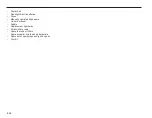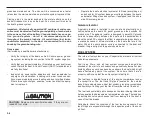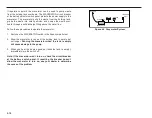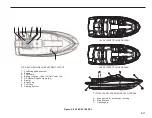
•
After refueling, wipe up or wash off any excess or spilled fuel;
open all hatches and ports; and let the boat air out. “Sniff” your
bilges. Operate the bilge blower for AT LEAST FOUR MINUTES
before starting the engine.
Important: Do not operate your boat until the source of a fuel
leak is identified. Have a qualified service technician correct
the condition. NEVER USE A MATCH TO INSPECT FOR LEAKS.
At Least Annually:
(Performed by a qualified marine technician)
•
Replace fuel system components if any evidence of cracking,
corrosion or deterioration is found.
•
Inspect fuel tanks annually. Pay particular attention to bottom
surfaces that may have contacted bilge water. Also, check to
see if any part of the tank is corroded or damaged from rubbing
and abrasion. Permanently installed fuel tanks must be vented
to the atmosphere outside the boat. Closed compartments that
contain fuel tanks and engines or non-ignition protected electri-
cal components must be ventilated.
•
Be sure the fill pipe is securely mounted, grounded and located
where spilled fuel is directed overboard. Dry and cracked or soft
and mushy fuel fill hoses should be replaced immediately.
•
If your boat is equipped with bilge blowers, ensure they are
working properly.
•
Ensure cooking appliances on board are secured and operate
properly. Refer to the appliance owner’s manual for guidance on
inspecting for leaks in valves and connections. NEVER USE A
MATCH to inspect for leaks.
•
Ensure flammable items are stowed safely and cannot contact
cooking appliances or hot engine parts.
•
Ensure fire extinguishers are USCG-approved and in good
working order (i.e., gauges register and nozzles are clear).
•
Repair all bare wires and loose electrical connections that might
cause a short in your boat’s electrical system and start a fire.
•
Do not store disposable propane cylinders or charcoal lighting
fluid on board the boat.
•
When replacing starters, generators or other electrical
equipment use only ignition-protected parts. Do not use
automotive parts.
Navigational Aids Chart
The Navigation Aids Chart (located at the end of this section) con-
tains information about various signals, buoys, and warnings.
Chaparral recommends you participate in a safe boating course to
learn more about navigating your boat safely.
WATER SPORTS
Water skiing and other water sports, such as kneeboarding and rid-
ing on inflatable towable devices, require an increased safety
awareness by all the people involved.
Important: Remember that three people — not two — are
required for safe water skiing: the boat operator, the skier, and an
observer on the boat facing the skier. The observer relays signals
from the skier to the operator. The operator can therefore give
full attention to the operation of the boat and the waters ahead.
2-12
WARNING:
Death or serious poisoning can result from expo-
sure to carbon monoxide from engine exhaust. Turn off
gasoline-powered generators that exhaust at or near the water
level when the swim platform on the stern is in use. Swimmers
should not enter the cavity beneath the swim platform.
Summary of Contents for 2012 SSi
Page 15: ...1 7...
Page 16: ......
Page 20: ......
Page 49: ...3 14...
Page 74: ...5 16...
Page 75: ...5 17...
Page 93: ......
Page 101: ......
Page 108: ...WIRING SCHEMATICS 12 12 1 196 206 216 SSI...
Page 109: ...12 2 196 206 216 SSI...
Page 110: ...12 3 226 SSI...
Page 111: ...12 4 226 SSI...
Page 112: ...12 5 246 SSI...
Page 113: ...246 SSI 12 6...
















































